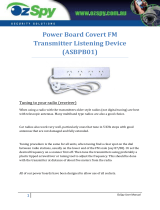
I
IMPORTANT WARRANTY INFORMATIONI PLEASE READ
Return Policy on Kits When Not Purchased Directly From Vectronics: Before continuing any
further with your VEC kit check with your Dealer about their return policy. If your Dealer
allows returns, your kit must be returned before you begin construction.
Return Policy on Kits When Purchased Directly From Vectronics: Your VEC kit may be
returned to the factory in its pre-assembled condition only. The reason for this stipulation is,
once you begin installing and soldering parts, you essentially take over the role of the device's
manufacturer. From this point on, neither Vectronics nor its dealers can reasonably be held
accountable for the quality or the outcome of your work. Because of this, Vectronics cannot
accept return of any kit-in-progress or completed work as a warranty item for any reason
whatsoever. If you are a new or inexperienced kit builder, we urge you to read the manual
carefully and determine whether or not you're ready to take on the job. If you wish to change
your mind and return your kit, you may-but you must do it before you begin construction,
and within ten (10) working days of the time it arrives
Vectronics Warrants: Your kit contains each item specified in the parts list.
Missing Parts: If you determine, during your pre-construction inventory, that any part js
missing, please contact Vectronics and we'll send the missing item to you free of charge.
However, before you contact Vectronics, please look carefully to confirm you haven't misread
the marking on one of the other items provided with the kit. Also, make certain an alternative
part hasn't been substituted for the item you're missing. If a specific part is no longer
available, or if Engineering has determined that an alternative component is more suitable,
Vectronics reserves the right to make substitutions at any time In most cases these changes
Defective Parts: Today's electronic parts are physically and electrically resilient, and defective
components are rare. However, if you discover an item during your pre-construction
inventory that's obviously broken or unserviceable, we'll replace it. Just return the part to
Vectronics at the address below accompanied with an explanation. Upon receipt, we'll test it.
If it's defective and appears unused, well ship you a new one right away at no charge.
Missing or Defective Parts After You Begin Assembly: Parts and materials lost or damaged
after construction begins are not covered under the terms of this warranty. However, most
parts supplied with VEC kits are relatively inexpensive and Vectronics can replace them for a
reasonable charge. Simply contact the factory with a complete description. We'll process your
order quickly and get you back on track.
Factory Repair After You Begin Assembly: Kits-in progress and completed kits are specifically
excluded from coverage by the Vectronics warranty. However, as a service to customers,
technicians are available
to
evaluate and repair malfunctioning kits for a minimum service fee
of $18.00
('/a
hour rate) plus $7.00 shipping and handling (prices subject to change). To qualify
for repair service, your kit must be fully completed, unmodified, and the printed circuit board
assembled using rosin-core solder. In the event your repair will require more than an hour to
fix (or 536.00, subject to change), our technicians will contact you in advance by telephone
before performing the work. Defective units should be shipped prepaid
to:
Vectronics
300 Industrial Park Road
Starkville, MS 39759
When shipping, pack your kit well and include the minimum payment plus shipping and
handling charges (525.00 total). No work can be performed without pre-payment Also,
rovide a valid UPS return address and a da
time
hone number where
ou ma
be reached.





















